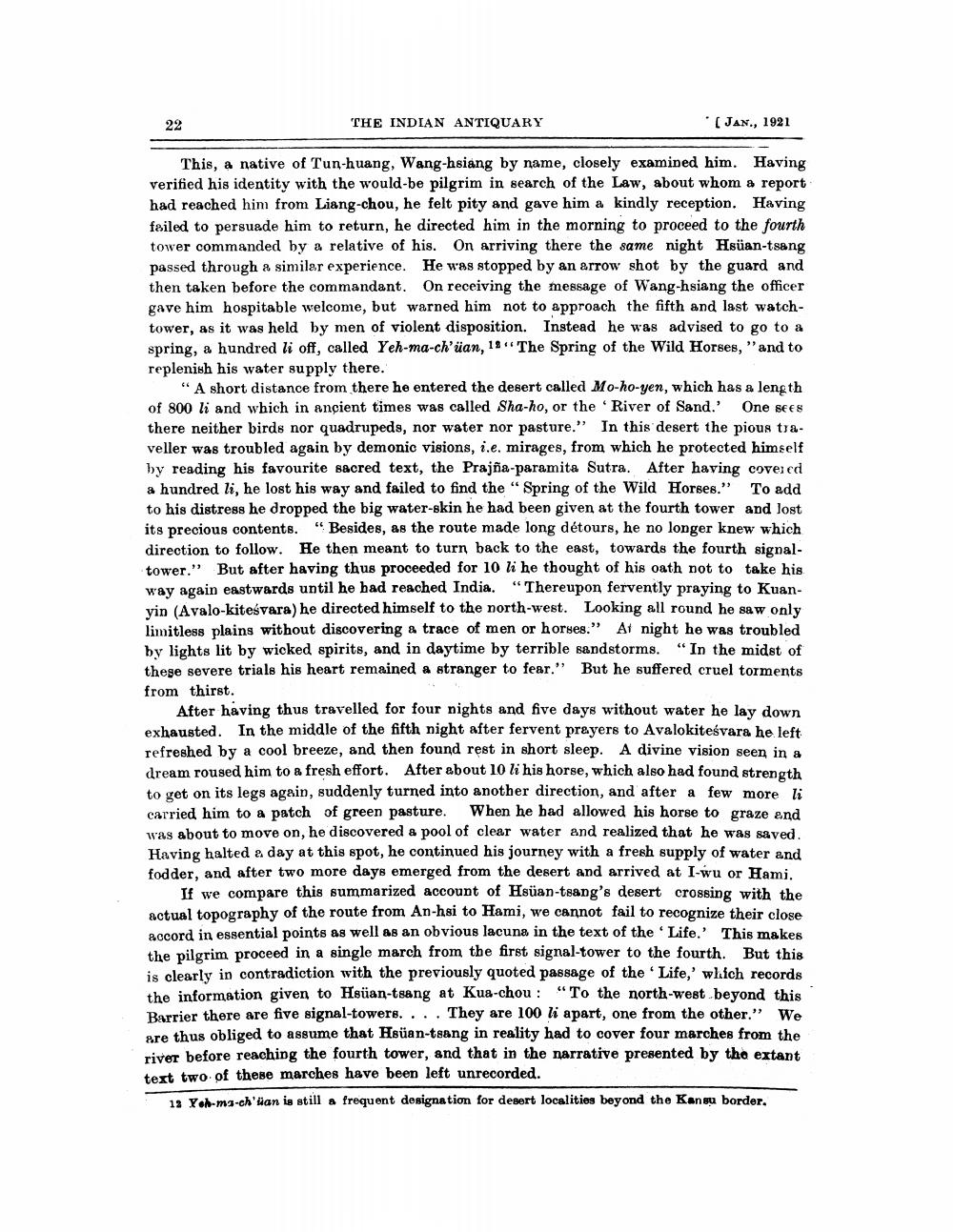________________
22
THE INDIAN ANTIQUARY
(Jan., 1921
This, a native of Tun-huang, Wang-hsiang by name, closely examined him. Having verified his identity with the would be pilgrim in search of the Law, about whom a report had reached him from Liang-chou, he felt pity and gave him a kindly reception. Having failed to persuade him to return, he directed him in the morning to proceed to the fourth tower commanded by a relative of his. On arriving there the same night Hsüan-tsang passed through a similar experience. He was stopped by an arrow shot by the guard and then taken before the commandant. On receiving the message of Wang-hsiang the officer gave him hospitable welcome, but warned him not to approach the fifth and last watchtower, as it was held by men of violent disposition. Instead he was advised to go to a spring, a hundred li off, called Yeh-ma-ch'üan, 18" The Spring of the Wild Horses, "and to replenish his water supply there.
"A short distance from there he entered the desert called Mo-ho-yen, which has a length of 800 li and which in ancient times was called Sha-ho, or the 'River of Sand.' One sees there neither birds nor quadrupeds, nor water nor pasture." In this desert the pious traveller was troubled again by demonic visions, i.e. mirages, from which he protected himself by reading his favourite sacred text, the Prajña-paramita Sutra. After having covered a hundred li, he lost his way and failed to find the "Spring of the Wild Horses." To add to his distress he dropped the big water-skin he had been given at the fourth tower and lost its precious contents." Besides, as the route made long détours, he no longer knew which direction to follow. He then meant to turn back to the east, towards the fourth signaltower." But after having thus proceeded for 10 li he thought of his oath not to take his way again eastwards until he had reached India. "Thereupon fervently praying to Kuanyin (Avalo-kitesvara) he directed himself to the north-west. Looking all round he saw only limitless plains without discovering & trace of men or horses.” At night he was troubled by lights lit by wicked spirits, and in daytime by terrible sandstorms. "In the midst of these severe trials his heart remained a stranger to fear." But he suffered cruel torments from thirst.
After having thus travelled for four nights and five days without water he lay down exhausted. In the middle of the fifth night after fervent prayers to Avalokitesvara he left refreshed by a cool breeze, and then found rest in short sleep. A divine vision seen in a dream roused him to a fresh effort. After about 10 li his horse, which also had found strength to get on its legs again, suddenly turned into another direction, and after a few more li carried him to a patch of green pasture. When he had allowed his horse to graze and was about to move on, he discovered a pool of clear water and realized that he was saved. Having halted a day at this spot, he continued his journey with a fresh supply of water and fodder, and after two more days emerged from the desert and arrived at l-wu or Hami.
If we compare this summarized account of Hsuan-tsang's desert crossing with the actual topography of the route from An-hsi to Hami, we cannot fail to recognize their close accord in essential points as well as an obvious lacuna in the text of the 'Life.' This makes the pilgrim proceed in a single march from the first signal-tower to the fourth. But this is clearly in contradiction with the previously quoted passage of the 'Life,' which records the information given to Heüan-tsang at Kua-chou: "To the north-west beyond this Barrier there are five signal-towers. ... They are 100 li apart, one from the other.” We are thus obliged to assume that Hsüan-tsang in reality had to cover four marches from the river before reaching the fourth tower, and that in the narrative presented by the extant text two of these marches have been left unrecorded.
19 Yeh-ma-ch'uan is still a frequent designation for desert localities beyond the Kansu border,




